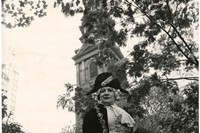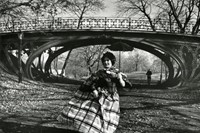We explore a series of work by legendary photographer Bill Cunningham, almost four decades after its creation
Bill Cunningham is universally beloved in the world of street style photography. A pioneer in his field, he has spent the past five decades cycling the streets of New York in his trademark blue anorak, snapping impeccably dressed passers by, for both himself and the New York Times. Unphased by celebrities, Cunningham simply photographs what he takes as great examples of personal style; indeed, over the years spotting trends has become second nature to him.
Today sees the New York Historical Society reconsider a series of Cunningham's earlier work in their new exhibition, Bill Cunningham: Facades. The collection is the result of an 8 year project undertaken by Cunningham in 1968, in which models – including Cunningham's late muse and fellow photographer Editta Sherman – donned period costumes across New York's historical sites in order to 'document the architectural riches and fashion history of New York City'. Originally collated in a tome of the same title, the images portray a rapidly transforming – and in some ways deteriorating – New York City juxtaposed with its traditional fashion counterparts, with timeless results.
"Fashion is the armour to survive the reality of everyday life. I don’t think you could do away with it. It would be like doing away with civilization" — Bill Cunningham
Following the release of the book, Cunningham donated all 88 silver gelatin prints from the series to the New York Historical Society, where they have quietly resided until now, whilst Cunningham – now 85 – has been busy adding to his expansive photographic collection. Revered and respected within the highest fashion circles, Cunningham is showing no sign of slowing down. For as long as there is fashion, he will be there to photograph it – "Fashion is the armour to survive the reality of everyday life. I don’t think you could do away with it. It would be like doing away with civilization."
Bill Cunningham: Facades is showing at the New York Historical Society until 15 June.



